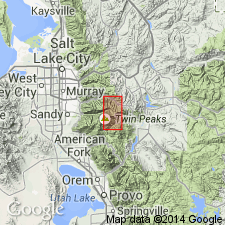
- Usage in publication:
-
- Maxfield limestone*
- Modifications:
-
- Mapped 1:25k
- Overview
- Dominant lithology:
-
- Dolomite
- Limestone
- AAPG geologic province:
-
- Wasatch uplift
- Uinta basin
Summary:
Mapped in western, central, and southern part of study area in Wasatch Mountains of north-central UT, Salt Lake and Utah Cos, Wasatch uplift and in Wasatch Co, Uinta basin. Consists mostly of dolomite and magnesian limestone. Rank term "limestone" is used because it is considered a more general term than dolomite. Can be divided into three members. Lower member consists of dolomite and limestone below top of a conspicuous layer of hard white dolomite; middle member consists of buff-mottled limestone, with some interbedded shale; and upper member consists of dolomite. Maxfield has characteristic textural features including oolitic, pisolitic, twig-like, "wormy" or "guinea-hen," and mottled textures. Cross sections; measured sections; generalized section where unit is shown to be 570 ft thick. Overlies Ophir shale; unconformably underlies Jefferson? dolomite. Considered most likely to be Middle Cambrian age based on fossils including ZACANTHOIDES cf. Z. SPINOSUS and OBOLUS (WESTONIA) ELLA which correlates it with Middle Cambrian Spence shale and MICROMITRA (IPHIDELLA) PANNULA. On generalized section (plate 5) age shown as Late Cambrian.
Source: GNU records (USGS DDS-6; Denver GNULEX).
For more information, please contact Nancy Stamm, Geologic Names Committee Secretary.
Asterisk (*) indicates published by U.S. Geological Survey authors.
"No current usage" (†) implies that a name has been abandoned or has fallen into disuse. Former usage and, if known, replacement name given in parentheses ( ).
Slash (/) indicates name conflicts with nomenclatural guidelines (CSN, 1933; ACSN, 1961, 1970; NACSN, 1983, 2005, 2021). May be explained within brackets ([ ]).

